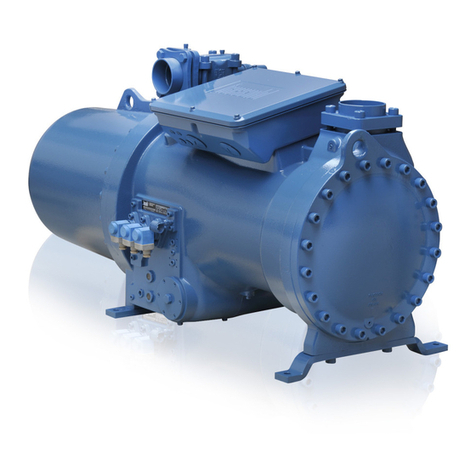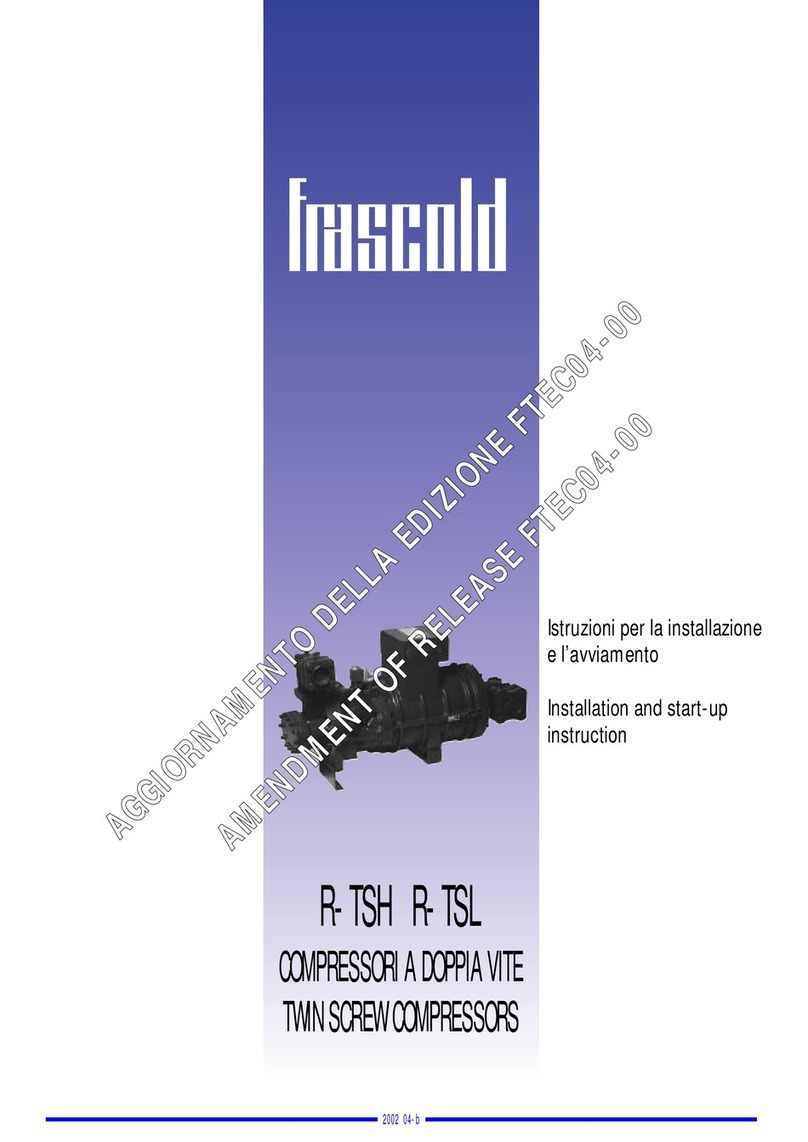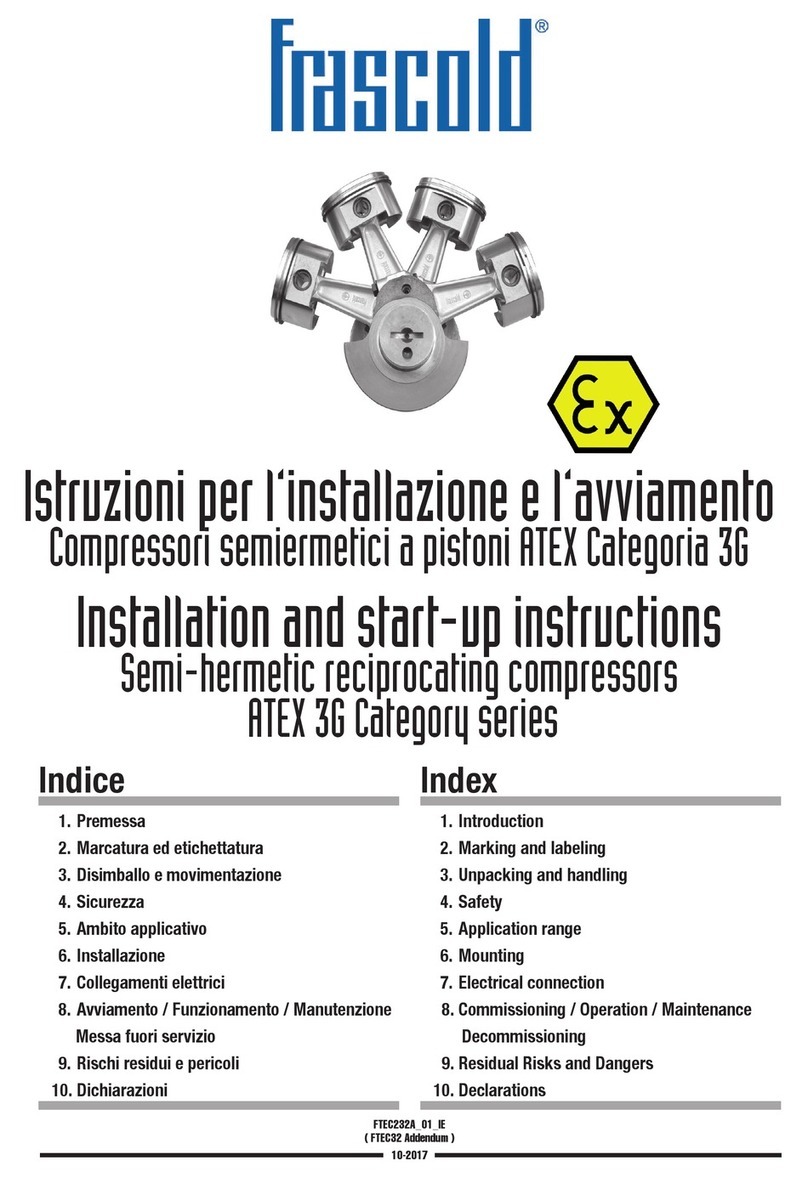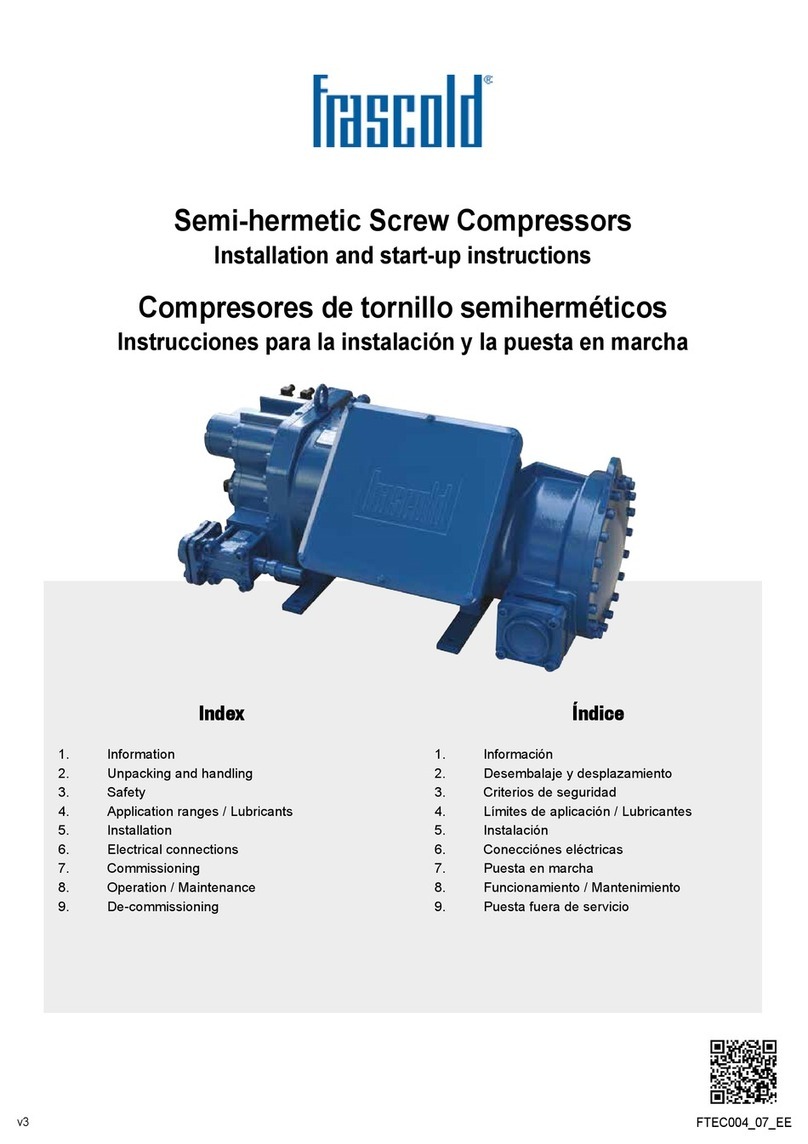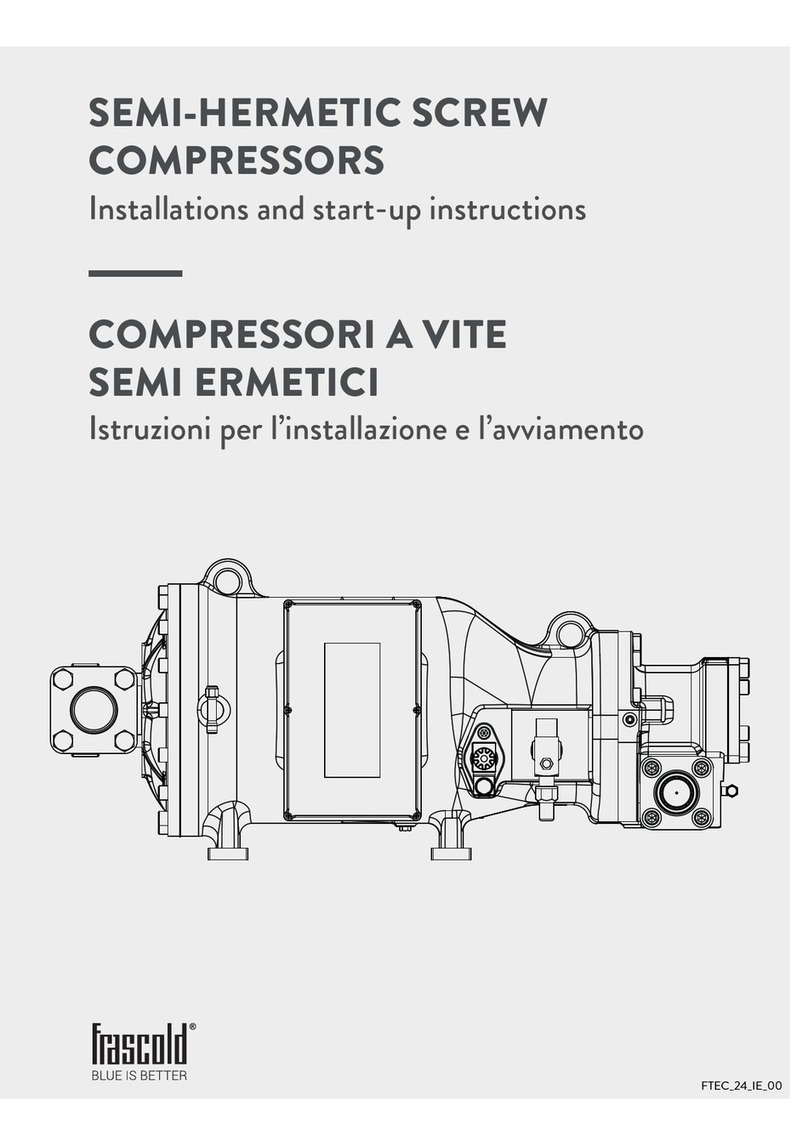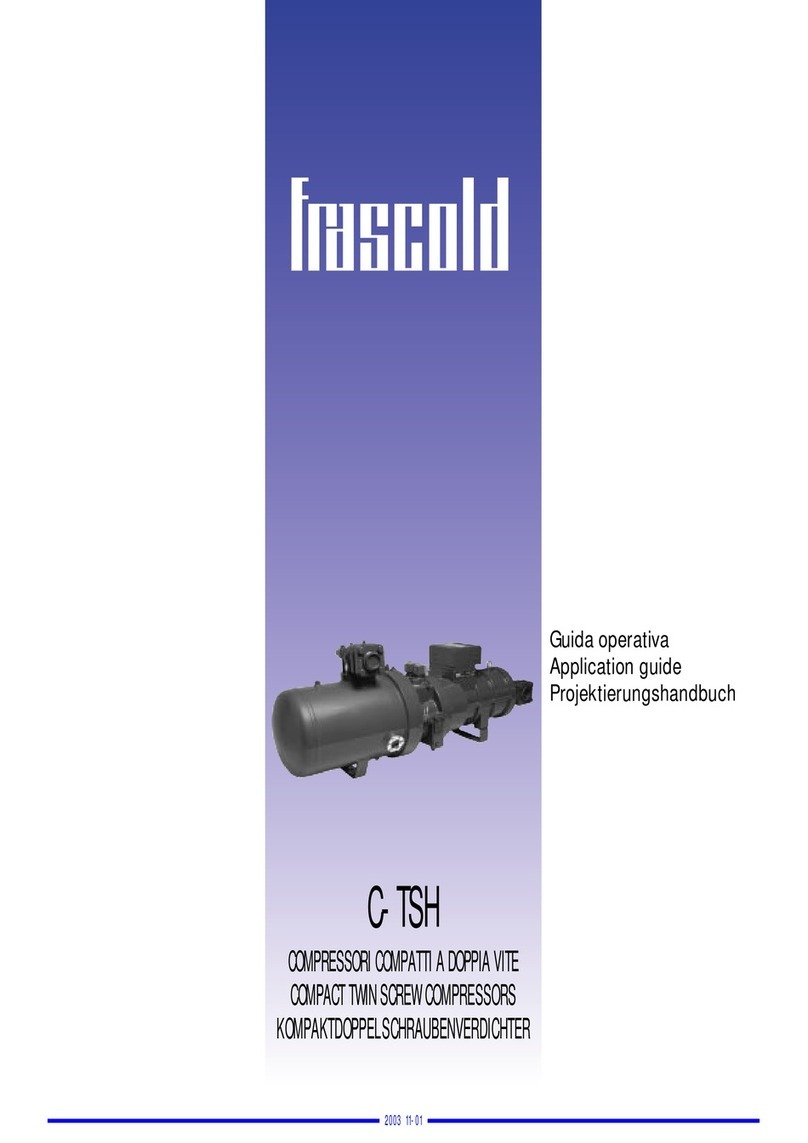
Istruzioni per la installazione e l’avviamento 6Installation and start-up instructions
FTEC04-00
1.3 La protezione
Icompressorivengonoforniti completidiprotezioneintegrale,conforme
alla norma DIN44081, costituita da una catena di termistori PTC
inseriti nello statore del motore elettrico e collegati a un modulo
elettronico di controllo KRIWAN (vedi schema 11.24,pagina 48).
Il dispositivo di protezione svolge le seguenti funzioni:
• controllo della massima temperatura del motore elettrico (+120°C)
mediante sei termistori di tipo PTC inseriti nell’avvolgimento dello
statore
• controllo della massima temperatura di compressione (+120°C)
tramite un sensore di tipo PTC posto sullo scarico del compressore
Durantei5secondisuccessiviall’avviamentodelcompressoreildispositivo
di protezione svolge le seguenti funzioni:
• controllodelsensodirotazionedelmotoreelettricoedellasuccessione
delle fasi
• protezione contro mancanza di fasi e cadute di tensione
• controllodiinterruzioniocortocircuitoneicircuitideisensoriPTC.
Per il collegamento dei dispositivi di protezione, consultare la sezione
"3.3Collegamentielettrici"a pagina 10 e gli schemi riportati a pagina 48
del presente manuale.
1.4 La scatola terminali
All'interno della scatola, sono alloggiati tutti i terminali per il collegamento
delcompressoreallaretedialimentazioneelettricaealcircuitodicontrollo.
Il corpo della scatola è realizzato in un unico pezzo ed il coperchio è
dotato di guarnizione tipo O-ring; grado di protezione IP65.
Per il collegamento elettrico del compressore, consultare il presente
manuale a pagina 10 "3.3 Collegamenti elettrici" e gli schemi riportati a
pagina 48.
1.5 La lubrificazione
Il compressore a vite è caratterizzato da un sistema di lubrificazione ad
iniezione di olio che oltre a provvedere alla lubrificazione delle parti in
movimento, agisce da sigillante tra i profili delle viti.
Duranteilsuofunzionamento,dalcompressoreavitefuoriesceunanotevole
quantità di lubrificante con una pressione pari a quella di compressione.
Un separatore d’olio esterno installato sulla linea di compressione, (vedi
figura 6) provvede a separare il lubrificante dal refrigerante.
Illubrificanteinalta pressione,attraversounalineaesterna,viene quindi
reimmessonelcompressoreeviene iniettato tra le viti eneicuscinetti.
L’interagammadicomponentiselezionatidaFRASCOLDperequipaggiare
la linea esterna di ritorno olio è illustrata a pagina 12.
In condizioni di impiego particolarmente gravose possono verificarsi alte
temperature del lubrificante, tali da richiedere il raffreddamento del
lubrificante stesso.
Nelletabelle“Campo di applicazione”della guida operativa e nel catalogo
alla sezione “Prestazioni”, sono indicate le condizioni di impiego per le
quali è necessario effettuare il raffreddamento del lubrificante.
1.6 Il lubrificante
Per i compressori a vite serie R-TS la necessaria carica di lubrificante è
interamente alloggiata all’interno del separatore d’olio remoto salvo una
piccola quantità che si trova nella linea esterna di lubrificazione e nel
compressore.
Il tipo di lubrificante e la sua viscosità sono commisurati sia al
refrigerantechealcampodelletemperaturedievaporazione alle quali
il compressore può operare; per maggiori dettagli, vedi pagina 32,
tavola "11.2 Lubrificanti".
La quantità di lubrificante da immettere è commisurata sia alle
dimensioni del separatore che a quelle della linea di lubrificazione
(vedi pagina 17,“6.1 La carica di lubrificante”).
Ogni sostituzione del lubrificante o eventuale reintegro della carica, deve
1.3 Protection
R-TS scrw compressors are supplied with integral protection, in
accordance to DIN44081 standard, with PTC thermistors placed
into the electrical motor stator and connected to an electronic control
module KRIWAN (see wiring diagram 11.24, page 48) with the
following functions:
• control of the maximum winding temperature (+120°C) through
six thermistors type PTC included in the stator wiring
• control of the maximum discharge temperature (+120°C) through a
thermistor type PTC located on the compressor discharge side
During 5 seconds coming after the compressor starting,the following
functions are carried on:
• control of the direction of rotation of electric motor and phase
sequence
• phase and voltage failure protection
• control of breakage and short circuit in chain of PTC sensors
As concern protection devices connection, consult section “3.3
Electrical connections” page 10 and wiring diagrams,page 48 of the
present manual.
1.4 Terminal box
Inside the box, there are all the terminals for compressor connection to
the electrical net and to the control and protection circuit.
The body of the box is manufactured as a single piece with the cover
having a O-ring seal giving an enclosure rating of IP65.
As per compressor electrical connection, consult the present manual
on page 10 "3.3 Electrical connections" and the the wiring diagrams
of page 48.
1.5 Lubrication
Thescrew compressor is characterised by a lubrication system based
on the injection of oil into the parts in motion; besides the lubrication,
oil seals the screw profiles.
During functioning, a huge quantity of lubricant comes out from the
screw compressor with a pressure equal to the discharge one.
Inordertoensure anexcellentlubricantseparationfromthe refrigerant,
it is necessary to install an oil separator (see fig. 6).
The lubricant at high pressure, by means an external oil piping, is
conveyed in to the internal lubrication circuit of the compressor and
injected on the screws and the bearings.
ThewholerangeofcomponentsselectedbyFRASCOLDand supplied
as standard equipment of the compressor to fit the external oil piping
is illustrated at page 12.
In case of particularly hard working conditions, the oil can reach high
temperature and lubricant cooling must be performed.
Inthetables“Applicationlimits”of application guide and in the section
“Performance data” of related catalogue are unmistakably showed
the working conditions when oil cooling is required.
1.6 Lubricant
For R-TS twin screw compressors the necessary oil charge is located in
to the remote oil separator and a small quantity in the external oil piping.
The lubricant type and its viscosity are fitted both to refrigerant and to
evaporating temperatures application range at which the compressor
may operate.
For further details, consult the table “11.2 Lubricants” on page 32.
The quantity of lubricant to charge into the system is related to the
innervolume of the oil separatorand with the length of theexternal oil
piping (see page 17,“6.1 Lubricant charge”).
Each lubricant replacement or eventual charge recovery have to be
absolutely effected with the same oil type originally contained or with
a type approved by FRASCOLD (see the table 11.2, page 32) and
